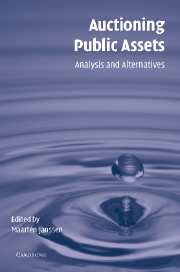Book contents
- Frontmatter
- Contents
- List of figures
- List of tables
- List of contributors
- Preface
- Introduction
- Part I Theory
- 1 Auction theory for auction design
- 2 Beauty Contest design
- 3 Preventing collusion among firms in auctions
- 4 Levelling the playing field in auctions and the prohibition of state aid
- 5 Allocation mechanisms and post-allocation interaction
- Part II Case studies
- Index
- References
5 - Allocation mechanisms and post-allocation interaction
Published online by Cambridge University Press: 03 December 2009
- Frontmatter
- Contents
- List of figures
- List of tables
- List of contributors
- Preface
- Introduction
- Part I Theory
- 1 Auction theory for auction design
- 2 Beauty Contest design
- 3 Preventing collusion among firms in auctions
- 4 Levelling the playing field in auctions and the prohibition of state aid
- 5 Allocation mechanisms and post-allocation interaction
- Part II Case studies
- Index
- References
Summary
Introduction
In many traditional auctions, the seller or auctioneer is only interested in the price obtained for the auctioned objects. That is, the sole objective is to raise revenue. But, whenever a government sells some rights, it is often the case that it is also interested in who will get the rights, and how the rights will be used. Generally speaking, when a market arises after an allocation mechanism is implemented (as is the case with mobile telephony frequencies, radio frequencies or the right to exploit petrol stations along highways) a government is also interested in welfare issues related to the functioning of the industry and the economy as a whole. Hence, the seller may try to establish at the allocation stage conditions that ensure a future competitive market. Thus, whenever an auction affects the way a market functions, the seller (government) may have multiple objectives rather than the single one of maximising revenue. One of the questions that arise is: how should these multiple objectives be ranked?
For potential bidders there are also fundamental differences between participating in a regular auction and participating in an auction which gives the winner(s) an entry ticket to the market that arises afterwards. When there is a market after the auction, bidders may care about who (else) wins the auction and with what rights. This implies that their valuations are endogenous: they depend on the entire partition of objects among potential bidders.
- Type
- Chapter
- Information
- Auctioning Public AssetsAnalysis and Alternatives, pp. 130 - 144Publisher: Cambridge University PressPrint publication year: 2004
References
- 1
- Cited by



